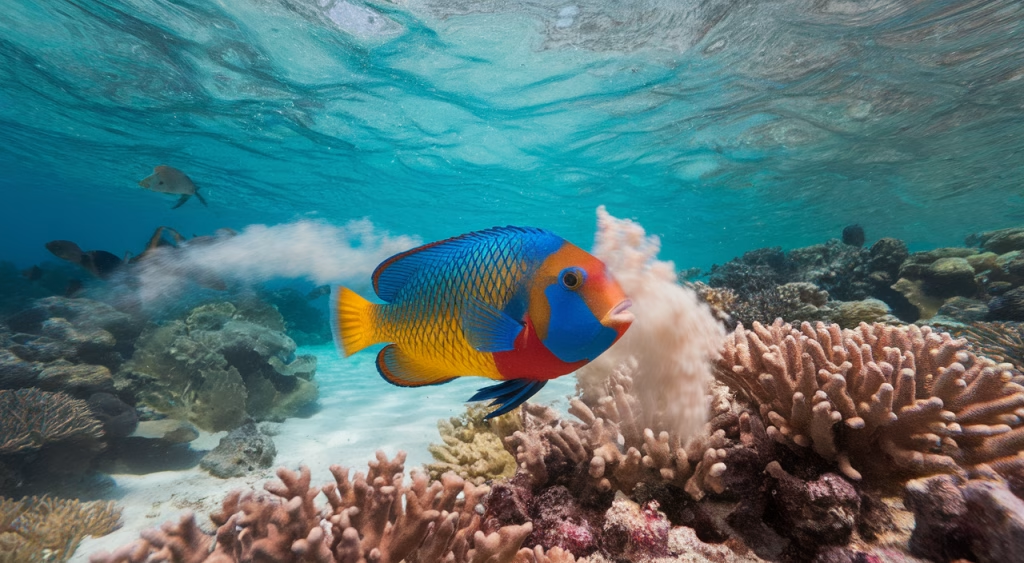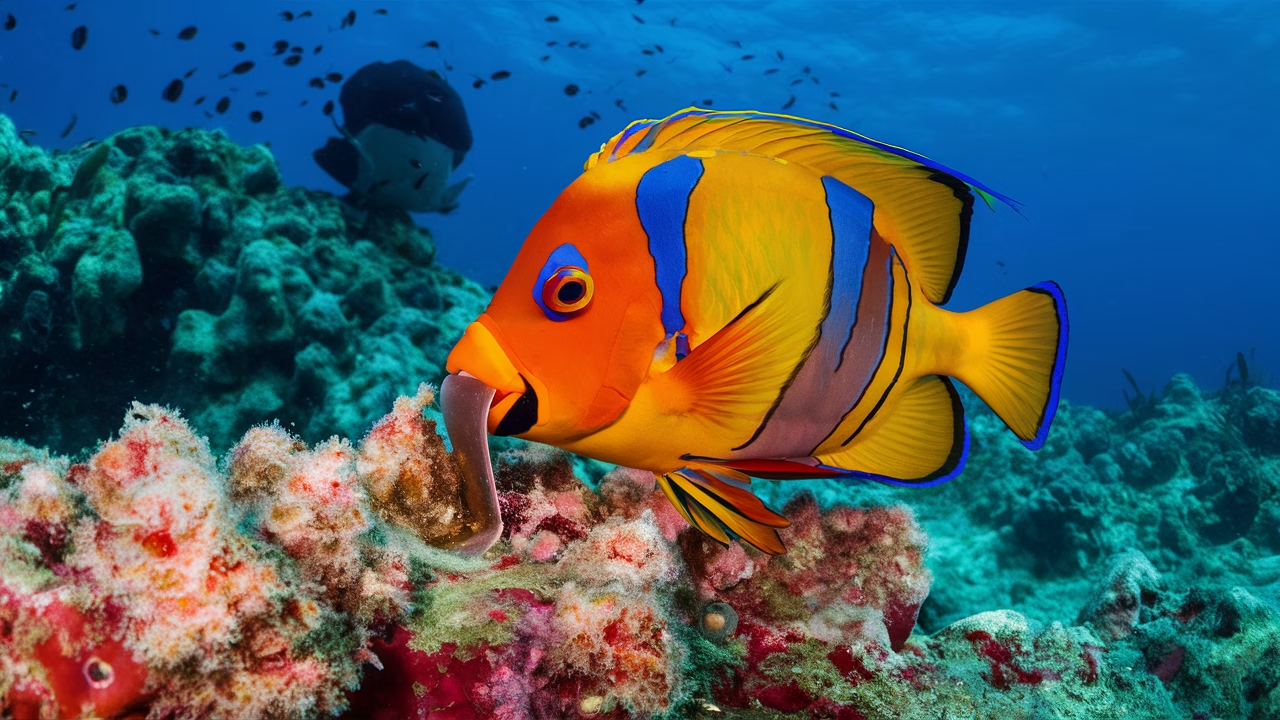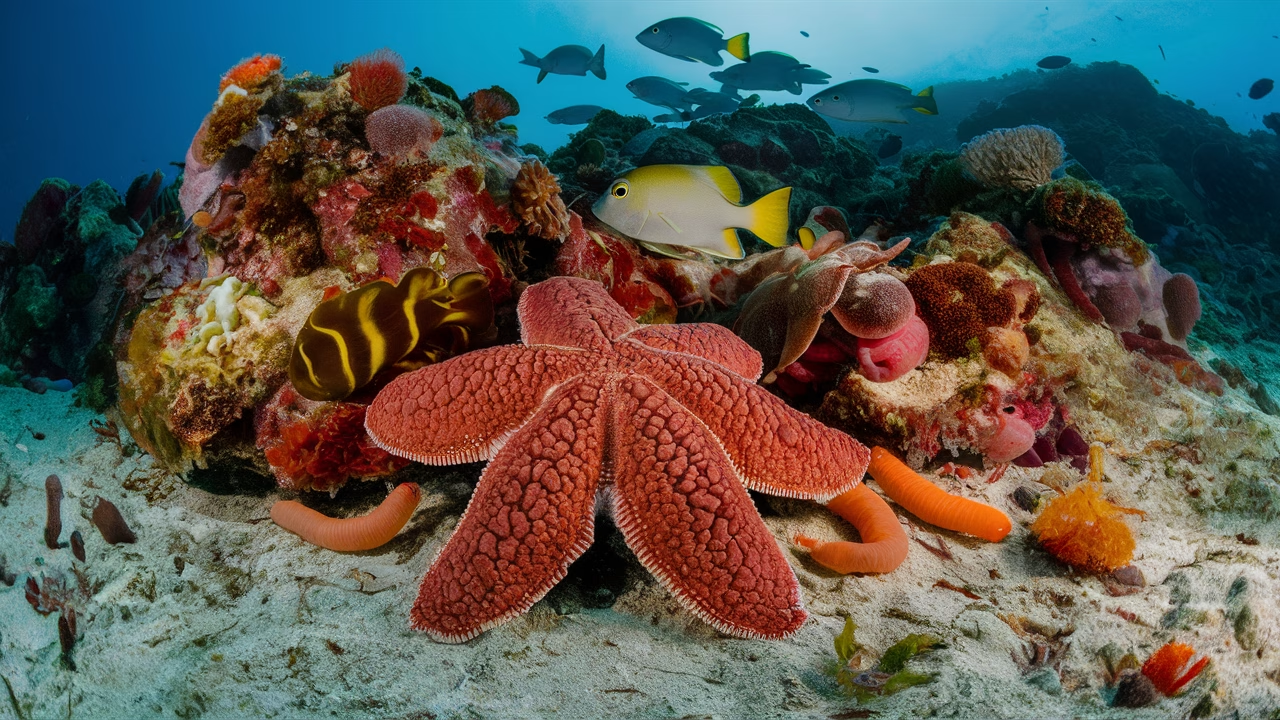How do parrotfish create white sand?
Parrotfish create white sand through coral grinding – they bite and scrape coral with their powerful beak-like teeth, digest the algae inside, and excrete the remaining coral fragments as fine white sand. This natural process of parrotfish poop sand formation contributes significantly to tropical beach creation and maintains healthy coral reef ecosystems.
TL;DR: Parrotfish Poop Sand—Nature’s Sand Factory
- Coral grinding machines: Parrotfish use sturdy beaks to scrape algae-covered coral.
- Digestive magic: They absorb nutrients from the organic matter, excreting the inert materials as sand.
- Beach sculptors: One large parrotfish can produce over 200 pounds of sand annually!
- Marine heroes: Their actions maintain coral reef balance and support countless benthic organisms.
- Crucial conservationists: Without them, reefs could be smothered in algae, losing biodiversity.
The Role of Parrotfish in Coral Ecosystems
When you walk across those pristine white sand beaches in tropical paradise, you’re literally stepping on parrotfish poop sand. These vibrant marine species are far more than colorful reef decorations—they’re essential engineers of coral reef ecosystems and beach formation.
In coral ecosystems, parrotfish function as nature’s reef cleaners. They feed primarily on algae that grows on coral surfaces through a process called coral grinding. Without parrotfish constantly grazing, algae would smother coral reefs, preventing new coral growth and destroying marine biodiversity. Their feeding habits keep coral reefs healthy and thriving.
The white sand production from parrotfish extends far beyond reef maintenance. This sand feeds coastal systems, creates vital benthic habitats, protects shorelines from erosion, and supports entire marine food webs from the seafloor up.
Understanding Coral Grinding
The parrotfish’s beak-like jaws are perfectly designed for coral grinding. These powerful jaws don’t randomly destroy coral—instead, they target dead or algae-covered sections to extract nutritious microalgae and organic matter from within the calcium carbonate coral skeleton.
During coral grinding, parrotfish bite into coral structures and use specialized pharyngeal teeth (arranged like grinding mills) to pulverize coral fragments. This process separates digestible algae from indigestible coral material. What emerges as parrotfish poop sand is clean, fine calcium carbonate—the building blocks of those famous white sand beaches you love.
The Impact on Beach Formation
While ocean waves shape coastlines, parrotfish are the unsung heroes of white sand production in tropical regions. Each coral grinding session by a parrotfish contributes tiny amounts of sand, but when you consider that large parrotfish produce hundreds of pounds annually, their impact on beach formation becomes clear.
Parrotfish poop sand plays crucial roles in:
- White sand production: Fine calcium carbonate particles create those iconic tropical beaches.
- Beach formation: Continuous sand deposition builds and replenishes coastal shorelines over time.
- Coastal protection: Sand buffers shores from wave energy, protecting marine habitats and human communities.
Parrotfish Sand Production
Think of each parrotfish as a living sand factory. Large parrotfish can produce up to 800 pounds of white sand over their lifetime through constant coral grinding and digestion. When you multiply this by entire parrotfish populations on coral reefs, you begin to understand their massive contribution to beach formation.
Here’s how much sand different parrotfish species produce through coral grinding:
| Species | Average Size | Sand Produced Per Year |
|---|---|---|
| Bumphead Parrotfish | Up to 4 ft | Over 800 lbs |
| Stoplight Parrotfish | 1–2 ft | Around 200 lbs |
| Queen Parrotfish | 1.5–2.5 ft | Approx. 100-150 lbs |
Supporting Benthic Life
Beyond coral grinding and white sand production, parrotfish significantly impact benthic organisms—the diverse life forms living on and in seafloor sediments. These benthic communities include worms, crustaceans, echinoderms, and countless microscopic organisms that form the foundation of marine food webs.
Parrotfish support benthic life through:
- Habitat creation: Coral grinding and sand redistribution creates diverse microhabitats for benthic organisms.
- Sediment oxygenation: Constant sand movement from parrotfish poop sand improves oxygen circulation in seafloor sediments.
- Nutrient cycling: Their feeding and excretion enriches benthic environments, supporting entire food webs.
Habitat Creation by Parrotfish
After parrotfish complete their coral grinding, they leave behind clean coral surfaces that become prime settlement areas for new coral larvae. This constant renewal of substrate through their feeding habits is essential for coral reef regeneration. Without this process, coral reefs would decline rapidly, taking entire marine ecosystems with them.
Final Thoughts on the Ecological Role of Parrotfish
Understanding how parrotfish poop sand reveals the intricate connections within marine ecosystems. These remarkable fish serve as algae controllers, white sand manufacturers, biodiversity supporters, and coral reef engineers all at once through their natural coral grinding behavior.
For anyone who cares about ocean health and those beautiful beaches we all love, protecting parrotfish populations is crucial. Supporting sustainable fishing practices, marine protected areas, and coral reef conservation ensures that parrotfish can continue their vital work of coral grinding and beach formation for future generations to enjoy.
Frequently Asked Questions
- Do all parrotfish species produce sand?
Yes, all parrotfish species produce sand to varying degrees by grinding coral and excreting the indigestible remnants. - Is parrotfish poop really what makes white sand?
In many tropical regions, yes. A large portion of white sand on beaches comes from the fragmented coral passed through parrotfish digestive systems. - Can the disappearance of parrotfish impact coral reefs?
Absolutely. Without parrotfish, algae can overgrow, choking corals and diminishing biodiversity in the reef ecosystem. - Are parrotfish protected in marine reserves?
In many areas, yes. Due to their importance, marine reserves often list them as protected species to reduce overfishing. - What’s the link between parrotfish and benthic organisms?
Parrotfish support benthic life by enriching and turning over seafloor sediment, creating habitats and improving nutrient cycling. - Can humans influence parrotfish populations?
Fishing regulations, pollution control, and reef conservation programs can all directly affect parrotfish survival rates. - What other animals contribute to beach sand?
Sea urchins and some types of marine worms also contribute to sand formation, though not nearly at the scale of parrotfish.





